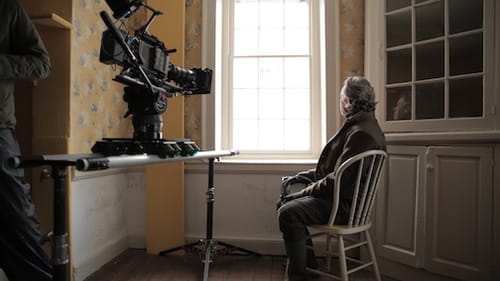Stay in the Loop
BSR publishes on a weekly schedule, with an email newsletter every Wednesday and Thursday morning. There’s no paywall, and subscribing is always free.
A local 'American Master' gets his due
PBS and Glenn Holsten present 'American Masters: Wyeth'

Glenn Holsten’s insightful documentary Wyeth – part of PBS’s American Masters series – was screened recently (and appropriately) at a winery right down the road from Chadds Ford, Pennsylvania. The bucolic village is, of course, where Andrew Wyeth worked and lived all his life.
The PBS series, grouped into segments, includes Wyeth in “Artists’ Flight.” Four disparate but groundbreaking American artists get served up like a flight of wine; it's a tasting of styles that are similar and yet unique.
Philadelphia public television station WHYY mounted this member preview in a tent under towering trees on a sweltering evening. The spot was at first inundated by the buzz of insects and nearby Route 1 traffic. But as images took hold, distractions disappeared into the life of the film’s subject, the aim of any auteur.
One film, several options
Holsten shot and cut two Wyeth films: a 60-minute version to be aired on WHYY and an 83-minute theatrical release (also on DVD) to be screened locally at the Kimmel Center and Ambler Theater. For this preview, which he bookended with an introduction and post-film discussion, Holsten excerpted 53 minutes of his longer film, spiking his remarks with tantalizing glimpses of what was not included. But what was there was riveting.
PBS promotes the film as “the story of one of America’s most popular but least understood artists.” Wyeth achieved artistic prominence early in his career – his first show of watercolors at New York’s Macbeth Gallery sold out – and he was duly lionized. But popularity and financial success made the young artist suspect among, and ultimately dismissed by, influential New York critics. These gatekeepers decried his “realism” and championed the sweeping tide of abstraction and minimalism.
But Wyeth kept a steady course, tellingly illustrated in Holsten’s film, and like a seemingly deceptive Robert Frost poem, continued peering deeply into what he saw. His images are probing, filled with sadness, toughness, death, and nature informed and elevated by the places that were important to him. Wyeth never traveled far from his sources, and through the onslaught of critical opprobrium, he never wavered in his artistic vision.
Holsten navigates this terrain with sensitivity, and though clearly admiring of his subject, never veers into hero worship. Beautiful sweeping shots of the idyllic areas central to Wyeth’s oeuvre – Maine and Chadds Ford – carry the visual undertones of foreboding evident in much of the artist’s work.

Special access
Holsten had access to both art world and family sources. Rich visuals of art and the natural world are judiciously balanced by a look at the Brandywine School of illustration (from which Wyeth sprung) as well as world history, art history, and close consideration of Wyeth works.
Holsten also interviews many people close to the artist: residents, his famous model Helga, and art world professionals including Brandywine River Museum’s Wyeth curator Mary Landa. Some anecdotal humor sits just on the tasteful side of gossip.
Andrew’s son Jamie, heir to the Wyeth legacy and also an accomplished artist, talks about his father’s work and process. For Holsten, who embedded himself in all things Wyeth for over three years, that process was one of the surprises.
“[It] was new and remains fascinating to me,” said the filmmaker. “He didn't have a set plan for any one day. When he was not involved in the studio in a long-term tempera painting, I think he thought his job was to go out and wander and be receptive to what Chadds Ford (and Maine) had to show him.” This insight influenced Holsten, who found that “this kind of sensitivity to the world … really informed our filming.”
Holsten and Philadelphia production company FreshFly are not arts novices; their filmography includes works about the Barnes Collection and Longwood Gardens. So, it’s no surprise this film is polished and visually exciting. The surprise is that they were able to so effectively elucidate the complexities of Andrew Wyeth, man and artist.
Wyeth had a deeply personal yet universal view rooted – by family legacy and choice – in the two communities where his work thrived. In wine parlance, “terroir” is the set of environmental factors that affect a crop’s phenotype. It’s the composite of an organism’s observable characteristics or traits.
Holsten’s Wyeth offers a deep and welcome look at a man for whom terroir was the driving artistic force.
What, When, Where
Wyeth. Directed by Glenn Holsten. Airs on WHYY-TV's American Masters September 7, 2018, 10pm.
September 5, 2018, at the Kimmel Center's Perelman Theater, 300 S. Broad Street, Philadelphia. (215) 893-1999 or kimmelcenter.org.
September 12, 2018, at the Ambler Theater, 108 E. Butler Avenue, Ambler, Pennsylvania. (215) 345-7855 or amblertheater.org.
DVD, $14.29, available at Amazon.
Sign up for our newsletter
All of the week's new articles, all in one place. Sign up for the free weekly BSR newsletters, and don't miss a conversation.

 Gail Obenreder
Gail Obenreder